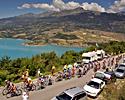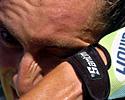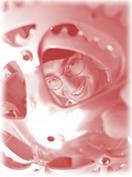
Recently on Cyclingnews.com |
|
|
View from the lab - Ric Stern's Tour de France sports science
British ABCC coach Ric Stern (www.cyclecoach.com) is a regular contributor to Cyclingnews' Form & Fitness section along with being a full time coach. Still an active rider when time allows, Ric will be providing a physiological insight into the challenges that face the riders in the Tour.
July 14: Stage 12 - Hot, hot, hot!

|
With the riders exiting the Alps, today is what I'd describe as lumpy. Continually up and down, and generally quite tiring. Yesterday I thought one of the big guns may attack (especially on the last climb of the day) or a long break away would establish itself. Thankfully, the latter part was correct, and a break was away for the majority of the stage.
Like yesterday, the riders in the break would have to work harder than those in the bunch. This is for a two-fold reason. Firstly, they are travelling at a greater average speed (so that they can distance themselves from the peloton) and secondly because the work on the front is being shared by fewer riders than back in the main peloton.
Early on while the break establishes itself it's imperative that everyone shares the workload in a breakaway attempt. Today it looked like once David Moncoutié had escaped the break that the other riders didn't work cohesively to bring him back. With seven pursuers it should have been possible to bring Moncoutié back, but this didn't happen and the Cofidis rider took a great win.

|
Back in the main peloton, the big guns would have basically had a day off (or as much of a day off as you can have while tackling five climbs and riding 187 km). This would allow them to recover a little and not burn through vast quantities of their stored carbohydrates (muscle and liver glycogen) as would happen when they are climbing the huge monster climbs in the Alps (it should be noted that fat is also oxidised on these stages, but the predominant fuel source on the big climbs will be carbohydrates). On today's stage they would have 'burnt' a mix of fuels (fats and carbohydrates) and hopefully as little carbohydrate as possible, while taking in as much carbohydrate and fluid as possible.
With today being the hottest day of the Tour so far it is absolutely critical to maintain good hydration levels. Even small amounts of dehydration can seriously affect performance, and can eventually become life-threatening. On the other hand, taking in too much water can actually be bad for you as this dilutes the amount of salt in your body, known as hyponatraemia, which can be fatal. During exercise, research constantly shows us that carbohydrate-electrolyte drinks of 6-8% solution are best for absorption and helping to maintain blood glucose. There are many drinks on the market, but choice will often come down to taste. Palatability is extremely important and you should choose a drink that tastes good on the bike (my favourite bike drink tastes revolting at home, but it's a great taste when I'm racing and training) as well as satisfying the 6-8 % carbohydrate range and containing a good quantity of electrolytes.

|
How much fluid do you require when on the bike? This is fairly simple to work out. Record your nude body mass directly before training and just after going to the toilet. During your bike ride, note how much you drink, and total training time. When you arrive home, strip, and towel dry and reweigh yourself. You can now work out your fluid requirements.
Example:
Pre ride mass = 70 kg
Post ride mass = 68 kg
Fluid consumed = 1.5 Litres
Training time = 2.5 hrs
Each litre of fluid drunk or weight lost is approximately equal to 1kg (2.2lb).
Fluid loss = pre ride minus post ride mass (70 - 68 kg = 2 kg)
Total fluid loss = 2kg plus fluid consumed (2 + 1.5 kg = 3.5 kg)
Total fluid loss rate = 3.5kg divided by 2.5 hrs = 1.4 litres per hour
Therefore in the above example the rider should try to drink approximately 1.4L/hr of carbohydrate-electrolyte solution. However, it may not always be possible to drink such volumes, so some researchers suggest aiming for about 75% of the requirement (i.e, a minimum of 1.05 L/hr in the above example). Once home, you should aim to drink 1.5 times the fluid loss (i.e, 2 x 1.5 = 3 litres in the above example) in a carbohydrate-electrolyte solution to restore fluid levels to normal (needs to have electrolytes in to prevent you from peeing out the fluid).
In my crystal ball I see a sprint finish tomorrow!
2005 entries - the Tour de France
- July 28 - Stage 21 - What it takes
- July 23 - Stage 20 - Getting the TT right - and wrong
- July 22 - Stage 19 - The perfect break
- July 21 - Stage 18 - High intensity and fatigue
- July 19 - Stage 16 - Maintaining an attack
- July 17 - Stage 15 - Tour's biggest day
- July 16 - Stage 14 - Attacks keep coming
- July 15 - Stage 13 - Positive thoughts
- July 14 - Stage 12 - Hot, hot, hot!
- July 13 - Stage 11 - Big efforts uphill
- July 12 - Stage 10 - Number crunching
- July 7 - Stage 6: The dynamics of a breakaway
- July 6 - Stage 5: Coming back after a TT
- July 5 - The TTT - Man, machine and team
Previous Cyclingnews features by Ric Stern
- Winter Training
- Weight training and cycling - The Great Debate
- Power zone training - How to set training levels with a power meter
- Ric Stern also answers Cyclingnews readers' questions in our Form & Fitness Q&A section

